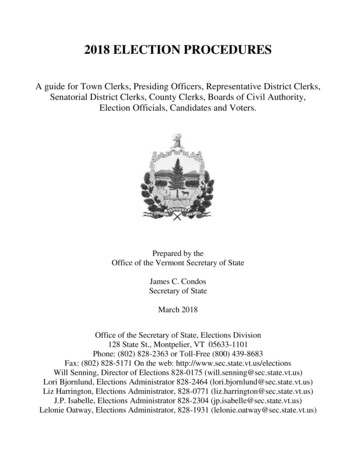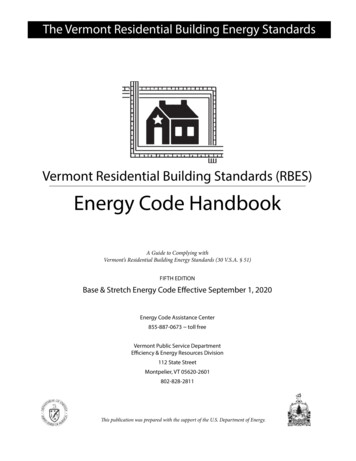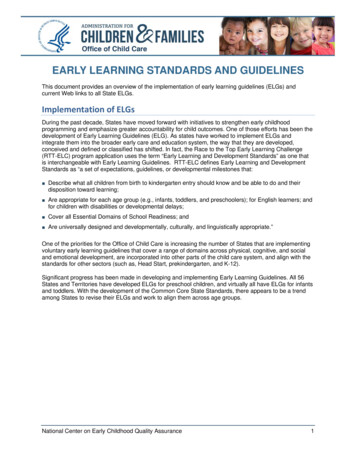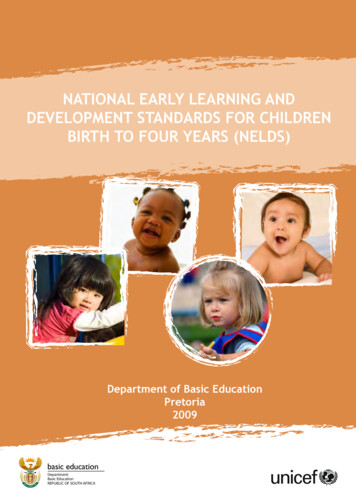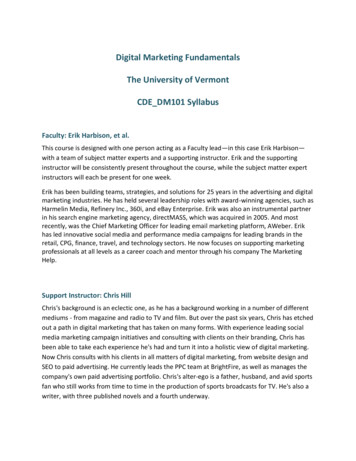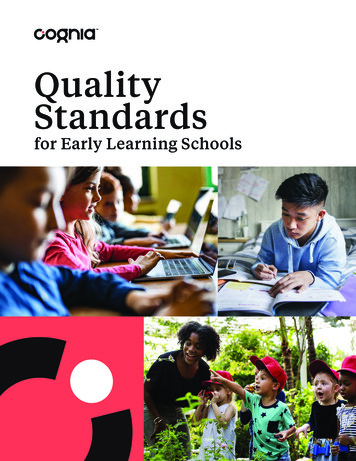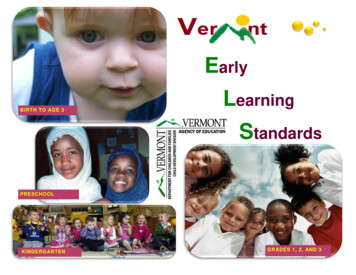
Transcription
EarlyBIRTH TO AGE 3LearningStandardsPRESCHOOLKINDERGARTENGRADES 1, 2, AND 3
ACKNOWLEDGEMENTSThere’s a saying that it takes a village to raise a child. When it came to re-conceptualizing and revising the Vermont Early LearningStandards, it took a committee of knowledgeable, dedicated individuals. It has taken many hours of meetings, research, livelydiscussions, drafts and re-drafts to eventually produce this version of the new Infants through Grade 3 Vermont Early LearningStandards. We also want to thank Catherine Scott-Little and Camille Catlett for their review and helpful feedback on the variousdrafts we submitted.On August 18th, 2015, these newly revised Vermont Early Learning Standards were approved by the Vermont State Board ofEducation. Members of the board include: Stephan Morse, Chair; Sean-Marie Oller, Vice Chair; Rainbow Chen, Krista Huling,Bonnie Johnson-Aten, William Mathis, Dylan McAllister, Peter Peltz, Mark Perrin, Stacy Weinberger and Rebecca HolcombeWe want to acknowledge the efforts of the individuals listed below in alphabetical order, the VELS Revision Committee.Ami EnglishBen AllenBeth PeloquinBrenda SchrammCarol BarbieriDee SmithJackie SpragueJamie O’HareJan WalkerJane Ross-AllenJanice StockmanJodi FarashahiKaren BurnellKarin EdwardsKate RogersKate RossLaurel BongiornoLindy JohnsonLois FullerLoree SilvisLori DolezalManuela FonsecaPat FitzsimmonsSharon AdamsTracy WattersonIn addition to the VELS Revision Committee members listed above, we acknowledge the contributions of Susan Bergeron, Rebecca Bishop,Marianne Davidson, Sandra Graves, Lynne Teker, and Kelley Todriff.The VELS publication and professional development were funded under Vermont’s Race to the Top Early Learning Challenge Grant.Edited by: Manuela FonsecaVermont Early Learning Standards (August 2015)Final Edits and Layout by: Kate Rogers
Table of ContentsINTRODUCTION 4-5IIGUIDING PRINCIPLES 6-7LANGUAGE DEVELOPMENT . 51PURPOSE 8-11LITERACY DEVELOPMENT . 62ORGANIZATION OF THE VELS . 12-14CREATIVE ARTS &EXPRESSION . 77VELS AT A GLANCE . 15-20ISECTION I – DEVELOPING SELFAPPROACHES TO LEARNING 2123SOCIAL AND EMOTIONALDEVELOPMENT 30SECTION II – COMMUNICATION & EXPRESSION 50IIISECTION III - LEARNING ABOUT THE WORLDMATHEMATICS . 88SCIENCE . 103SOCIAL STUDIES . 113GROWING, MOVING AND BEINGHEALTHY 39APPENDICES . 125RESOURCES XXGLOSSARY . XXVermont Early Learning Standards (August 2015)87
IntroductionThe importance of high quality early childhood experiences as the foundation for school success and lifelong learning has beendemonstrated by research, practice, and public opinion. Plainly said, early experiences matter—whether children are at home, inchild care, preschool, kindergarten, or the primary grades. The forces that shape these early experiences are embedded in families,schools, and communities, and are largely controlled by adults who have a stake in children growing and developing to their fullestpotential. These adult stakeholders come from a variety of backgrounds, and need a common understanding of the knowledge, skills,and dispositions that children gain through quality early childhood experiences, regardless of where they spend their waking hours.The Vermont Early Learning Standards (VELS) are central to a shared vision of what we want for young children in our state in theyears from birth to third grade.The first edition of the VELS was published in 2003 and was met with widespread approval from early childhood educators,administrators, parents, and policy makers. For the first time, Vermonters shared a common set of Standards that described theknowledge and abilities children should have from age 3 to the time they entered kindergarten. Having common Standards led toshared language and values for parents and educators, leaders and policy makers. Play was featured prominently in every domain ofthe VELS, and we all came together around the belief that young children’s play was the foundation upon which to foster learningacross all development and content area domains. We continue to hold this belief.Since 2003, Vermont has made critical advances in the way we approach early childhood education and services.Publicly funded prekindergarten education (pre-k) is universally available to all 3, 4, and 5 year olds not enrolled inkindergarten throughout the state. A child in public pre-k may be educated in a school-operated preschool, or in a high qualitycommunity-based preschool, Head Start, child care center or family home-based program;Children’s Integrated Services brought together early intervention, family support, nursing, early childhood and familymental health, and specialized child care supports under one umbrella to provide a continuum of child and familydevelopment services for pregnant women and children prenatal to age 6;Vermont has an Early Childhood Action Plan which acts as a blueprint for policy development at the state and communitylevel to address the needs of young children and their families. In 2013, Vermont secured a Race to the Top Early LearningChallenge Grant to build the systems and infrastructure that will make this Action Plan a reality;4Vermont Early Learning Standards (August 2015)
Common Core State Standards in English Language Arts and in Mathematics, and the Next Generation ScienceStandards are being implemented in K-12 classrooms across the state, and are resulting in changes to curriculum instructionand assessment; there is a clear focus on skills and deeper knowledge that prepare all children for success in college andcareers;Greater emphasis on finding valid and reliable ways to assess young children’s learning is prevalent. Vermont’s pre-kprograms share a common research-based assessment system, Teaching Strategies GOLD, which has solidified for earlyeducators the link between instruction and learning;Multi-tiered Systems of Support (MTSS) acknowledge meeting children where they are with universal high qualityinstruction, environments, and relationships for all children. MTSS and Early MTSS for young children prior to kindergarten,provide targeted teaching and support for those children who need more instruction to gain skills, with intensive interventionsavailable for children whose academic and behavioral needs are the greatest.Beginning in 2012, a cross-section of early childhood development and education stakeholders was convened to begin thetask of revising the VELS. The VELS Revision Committee included higher education representatives, teachers, policymakers,state agency personnel, Head Start practitioners, content area experts, special educators and early interventionists. Theyagreed that early childhood is the period of human development defined as the years from birth to age 8 and decided to adopta birth through third grade continuum of Standards. Research has proven that when curriculum, instruction, and assessmentare linked through the early childhood years, children do better. Looking at it this way, it makes sense to align Standards andassessment along a continuum from birth to grade 3. The VELS Revision Committee has worked from 2012 to the presentto synthesize the changes in knowledge, research, and practice, both across the country and in Vermont, and makerecommendations for a new set of Vermont Early Learning Standards. In 2013 the first draft of the new VELS was produced.With support from Vermont’s Race to the Top Early Learning Challenge Grant (ELC), Catherine Scott-Little, a national experton early learning Standards was hired to review drafts and engage in an iterative process with the Committee. Feedback fromDr. Scott-Little led to Draft 2 in 2014 and another round of revisions to produce Draft 3 which was shared with the public for itsfeedback and comment. As a result of this review and subsequent public comment, VELS was revised to better capture theessential areas of development and learning in the early childhood years from infancy through grade three.Vermont Early Learning Standards (August 2015)5
Guiding PrinciplesWe believe that:1. Each and every child has promise. No matter their circumstances, we don’t give up on children.2. Each and every child develops and learns trust and respect through nurturing, responsive, and predictable relationshipswith family members, early childhood professionals and other adults and children.3. Each and every child forms ideas of how the world works and their place in it through actively interacting with people,formal and natural environments and objects.4. Each and every child has a unique life story written by its family, community, culture, heritage, language, beliefs andcircumstances.5. Each and every child learns and develops best when nutritional, physical and emotional needs are met, and when theyfeel safe and valued.6. Families are a child’s first, most consistent and important teachers.7. Each family deserves respect and support as partners and decision makers in the education and development of theirchildren.8. Home language and culture are essential components of each family’s identity; they are to be valued and maintained.9. Young children learn through play, physical activity, exploration, inquiry, engagement, asking questions, andcommunicating with adults and other children.10. Learning opportunities that are relevant, integrated across developmental domains, based on children’s interests, andbuild on children’s current knowledge and abilities are most effective in supporting each child’s full potential.6Vermont Early Learning Standards (August 2015)
11. To best support each and every child, early childhood professionals need the knowledge and skill to design, implement,assess, and adapt developmentally, culturally, linguistically, and individually appropriate practices.12. Early childhood practices need to be evidence-based, aligned, cumulative, and appropriate to each child’s developmentallevels and needs.13. Each and every child benefits from a continuous and seamless sequence of educational and developmental supportsthroughout early childhood (birth through third grade) to maximize their full participation and diminish the challenges oftransitions. This consistency is particularly important for young children who are most at risk.Vermont Early Learning Standards (August 2015)7
Purpose of VELSThe VELS is intended to be a resource for families, teachers, caregivers, administrators, and policy makers to answer twoquestions:What should children know and be able to do to prepare them to succeed in school and in life?What experiences should be available in homes, schools, and communities to help them gain the knowledgeand skills that prepare them for school and life?If you are a parent the VELS will make you familiar with what your child is learning in child care, preschool, or grades K-3 andserve as a guide to the opportunities at home and in the community that prepare your child for success throughout school andlife.If you are an early childhood teacher the VELS are your framework for curriculum and instruction. While they do not dictatehow you should teach, they do guide and inform what early childhood experiences you should support, facilitate and provide;and what you should teach. VELS also inform how your curriculum and instruction should be tailored, how play can beincorporated into your curriculum and instruction, and how educational practices should be aligned with these Standards.For teachers of infants, toddlers, and preschoolers, the VELS are aligned and incorporate DevelopmentallyAppropriate Practices (NAEYC);For preschool teachers working in Head Start settings and for teachers and caregivers in Early Head Startinfant and toddler settings, the VELS are aligned with the 2015 Federal Office of Head Start’s Head Start EarlyLearning Outcomes Framework, Ages Birth to Five;For K-3 teachers, the Common Core State Standards for English language arts and mathematics, the NextGeneration Science Standards, and Vermont’s Grade Level Expectations are built into the VELS.Vermont Early Learning Standards (August 2015)8
If you are a program or school administrator the VELS are a destination for what early childhood educators, teachers, andservice providers should be doing to guide children’s development and learning.If you are a policy maker refer to the VELS when making regulations or rules related to early childhood education andservices, and use them as a resource to familiarize yourself with what young children need in the years leading up to andincluding the early school years.Regardless of whether children are in preschool, elementary school, child care, or at home; whether they are typically developingor have diverse abilities and needs; whether they are learning to speak one language or many, the VELS represent commongoals for development and learning during the early childhood years. The VELS are a tool for adults who are responsible tounderstand these goals, and provide the opportunities and experiences that allow all children to make progress toward orachieve them, including making adaptations and accommodations for children’s unique circumstances.Use of the VELSThe VELS should be used to:Inform families about the development and capabilities of children birth through grade 3;Guide educators in the development and selection of program-wide curriculum and educational strategies;Individualize curriculum and strategies for each child and serve as a roadmap for experiences and skills the childshould begin developing next;Emphasize the importance of play as the foundation for children’s development and learning;Support referrals of children to qualified specialists when concerns about development are raised;Provide a framework for administrators to oversee curricular practices and advocate for resources; andContribute to a shared language and public awareness about the significance of early childhood education andexperiences, and the need to invest resources early and wisely.Vermont Early Learning Standards (August 2015)9
The VELS should not be used as:An assessment checklist,A comprehensive curriculum,A tool to diagnose or label children, or to keep children from progressing to the next level or grade,A mandate for specific teaching practices or materials,An evaluation of teachers or programs, orA rationale for excluding children from participating in programs or experiences.Using the VELS with All ChildrenEarly learning Standards make explicit the goals we have for children’s learning and development throughout the years frombirth to third grade. While we have these goals for all children, we recognize that some children will attain these goals earlier orlater than their chronological age would suggest. Children with disabilities or developmental delays may follow a course ofdevelopment that differs from their typically developing peers; their abilities may be delayed in one area but they may also bevery strong in another area.Some children learn English and another language at home, or start learning English when they come to preschool or first grade.Appropriately meeting the language, learning and cultural needs of these Dual Language Learners (DLL) requires specialattention.Acknowledging these differences does not diminish the importance of Standards to guide early childhood education and practicefor every child; rather it invites us to have a deep understanding of individual children, family culture, and adaptations andaccommodations that are needed for children who develop differently. Users of the VELS may need to look at Standards foryounger or older age groups as needed in order to understand what and how the child is learning now, and how to support thechild’s next steps. Often, you will have to make changes in your practice, environment, and activities to meet the needs of allchildren, and the VELS can support you in this workVermont Early Learning Standards (August 2015)1000
Using the VELS to Guide Intentional TeachingEvery day, young children should have experiences at home, in schools, and in their communities that make a difference to theirgrowing bodies and minds. As educators, we have a responsibility to notice and provide opportunities that make a positivedifference in their learning and development. Intentional teaching includes having instructional goals for children that guide ourinteractions, learning environments, and curriculum planning. The VELS provides a roadmap for intentional teaching bydescribing in detail our goals for the knowledge and skills children will gain through the early childhood years. “Intentionalteachers know their children, understand how to promote learning through individualized learning experiences, and reach out tofamilies to support enhanced, enriched, and emotionally nurturing experiences for all children.” (Getting it Right for YoungChildren from Diverse Backgrounds, Espinosa, Prentice-2010.)Vermont Early Learning Standards (August 2015)11
Grades 1, 2, 3KindergartenPreschoolBirth to 3Organization of the VELSVermont Early Learning Standards (August 2015)121
ORGANIZATIONThe Vermont Early Learning Standards begin with an introduction, explanations for how to use the VELS, and backgroundinformation about what is unique to Vermonters’ sensibilities and systems that underpin the early childhood years. Theintroduction is followed by the Standards themselves, which are presented in nine domains. The domains are the broad areas ofdevelopment and learning that are the focus of all that happens in the years from birth through third grade. The domains arepresented across three sections:I. Developing Self: Approaches to Learning, Social-Emotional Development, Growing, Moving, and Being HealthyII. Communication and Expression: Language Development, Literacy Development, Creative Arts & ExpressionIII. Learning about the World: Mathematics, Science, Social StudiesWithin each domain there are elements, goals, and indicators/expectations that describe the essence of what children shouldknow and be able to do during the early childhood years from birth to age 8.The domains and Standards are presented in nine age categories; some of which overlap intentionally in an effort todemonstrate the variation that is typical of early childhood development. The age breakdowns include chronological age as wellas conventional terminology:Infants (birth to 12 months)Younger toddlers (9-18 months)Kindergartners (5-6 year olds)1st graders (6-7 year olds)Older toddlers (18-36 months)Younger preschoolers (36-48 months)Older preschoolers (48-60 months)2nd graders (7-8 year olds)3rd graders (8-9 year olds)Vermont Early Learning Standards (August 2015)131
We emphasize that all domains are interrelated, interdependent, and of equal importance. This is true whether we are talkingabout an infant and the Social and Emotional Development domain, or a second grader and the Growing, Moving and BeingHealthy domain. The progress a child makes in one domain influences their accomplishments in other domains. For example itis widely accepted that children who are fatigued, hungry, or ill, will struggle to learn and participate fully in play and learningopportunities; the same is true for children who lack social skills or are challenged to regulate their emotions. All domains areimportant.Following the domain title is an introduction to the domain; it gives a brief summary on the important ideas in this domain andwhat you will find within it. The elements, goals, and goal statements provide further detail of the critical aspect of the domain,and the indicators/expectations are the specific statements of the expectations for development and learning in each age groupor grade level.Vermont Early Learning Standards (August 2015)14
VELS at a GlanceThe following chart provides a summary of the domains, elements, and goals of the Vermont Early Learning Standards:IDEVELOPING SELFDomainElements1. Play and ExplorationApproaches toLearningSocial and EmotionalLearning andDevelopment2. Initiative3. Problem Solving1. Emotion and Self-Regulation2. Self-Awareness3. Relationships with Adults andPeers1. Motor Development andCoordinationGrowing, Moving, andBeing Healthy2. Health and Safety PracticesGoals1. Children engage in play to understand the world around them1. Children show curiosity about the world around them, and take action to interact withit and learn.1. Children display an interest in novel situations, and demonstrate flexibility, creativityand innovation in solving challenging tasks.1. Children express a range of emotions, and regulate their emotional and socialresponses.1. Children demonstrate awareness of their personal characteristics, skills, and abilities.1. Children develop healthy positive relationships with adults and peers.1. Children develop strength, coordination, and control of their large muscles.2. Children develop strength, eye-hand coordination, and control of their small or finemotor muscles.1. Children develop healthy eating habits and knowledge of good nutrition.2. Children develop personal health and self-care habits, and become increasinglyindependent.3. Children develop the ability to identify unsafe situations, and use safe practices.15Vermont Early Learning Standards (August 2015)1
IICOMMUNICATION and EXPRESSIONDomainElements1. Receptive Language(Listening)1. Young children attend to, comprehend, and respond to increasingly complexlanguage.2. Expressive Language(Speaking)1. Young children use increasingly complex vocabulary and grammar to express theirthoughts, feelings, and ideas.3. Speaking & ListeningLanguageDevelopment4. Social Rules of Language5. Language6. Dual Language Learners –Receptive and ExpressiveEnglish Language Skills1. Foundational Reading SkillsLiteracy DevelopmentGoals2. Reading2a. Engagement with Literatureand Informational Text (0-5)2. Reading2b. Engagement with Literature2. Reading2c. Reading Informational Text1. Children demonstrate an increasing ability to comprehend and participate incollaborative conversations1. Young children initiate and maintain conversations with others while developingknowledge and use of the social rules of language.1. Children demonstrate increasing knowledge and use of the conventions of StandardEnglish and an ability to think about language.1. Young children whose home language is not English demonstrate the ability to listen,understand, and respond to increasing more complex spoken English.1. Children develop the foundational skills needed for engaging with print, reading andwriting1. Children develop “book language” and demonstrate comprehension.1. Children demonstrate knowledge of the key ideas and details of stories read to themand which they read, the craft and structure of literature, the ability to integrateknowledge and ideas, and to read a range of text with text complexity appropriate totheir grade level.1. Children demonstrate knowledge of the key ideas and details of stories read toVermont Early Learning Standards (August 2015)161
IICOMMUNICATION and EXPRESSION (continued)DomainElements2c. cont’dLiteracyDevelopment3. Writing4. Dual Language Learners –Literacy in English1. Visual ArtsCreative Arts andExpression2. Music3. Theatre (Dramatic Play)4. DanceGoalsthem and which they read, the craft and structure of informational texts, the ability tointegrate knowledge and ideas, and to read a range of text with text complexityappropriate to their grade level.1. Children demonstrate the understanding that writing is a means for communication.With increasing fine motor skills and experiences with literacy, children begin to usewriting conventions. (0-5)2. Children demonstrate their increasing ability to write various types of text for differentpurposes, organize their writing around a topic, participate and eventually conductresearch to gather information to use in their writing about a topic. (CCSSK-3)1. Young children, whose home language is not English, demonstrate an increasingability to engage in literacy experiences in English.1. Children create art using a variety of tools and art media to express their ideas,feelings, creativity, and develop appreciation of the art created by others.1. Children engage in making and listening to music as a vehicle for expression andlearning.1. Children engage in dramatic play and theatre as a way to represent real-lifeexperiences, communicate their ideas and feelings, learn, and use their imaginations.1. Children use movement to creatively express their ideas and feelings, and to learn.17Vermont Early Learning Standards (August 2015)1
IIILEARNING ABOUT THE WORLDDomainElement1. Number Sense, quantity, andCounting1a. Number Sense and Quantity1. Number Sense, quantity, andCounting1b. Counting and CardinalityMathematicsGoal1. Children count in sequence and by multiples, represent numerals, connect countingto cardinality, and compare quantities.1. Children count in sequence and by multiples, represent numerals, connect countingto cardinality, and compare quantities.Number Relationships andOperations2a. Number Relationships andOperations1. Children increasingly use numbers to describe relationships and to solvemathematical problems.Number Relationships andOperations2b: Operations and AlgebraicThinking1. Children develop and use concepts, properties, and representations of number thatextend to other number systems, to measures, and to algebra.2. Number Relationships andOperations2c: Numbers and Operations inBase Ten2. Number Relationships andOperations2d. Numbers and Operations inBase Ten –Fractions1. Children develop an understanding of the base-ten system and use place-valuenotation.Vermont Early Learning Standards (August 2015)1. Children understand fractions as numbers, and use that knowledge to comparefractions and explain the equivalence of fractions.181
IIILEARNING ABOUT THE WORLD (continued)DomainMathematicsElementGoal3. Measurement, Classificationand Data3a. Measurement, Comparison,Classification, and Time1. Children develop awareness of the differences of the objects and learn to sort,compare and classify objects by their attributes and properties. They also develop arudimentary sense of time based mostly on common routines.3. Measurement, Classificationand Data3b. Measurement and Data1. Children compare and classify objects according to their attributes, use Standardand non-Standard units of measure, tell time and work with units of money. Theydevelop the ability to represent and interpret data, and use operations to solveproblems related to measurement including geometric measurement.4. Geometry and SpatialReasoning4a. Geometry and Spatial Sense1. Children increasingly recognize two- and three-dimensional objects and use spatialreasoning.4. Geometry and SpatialReasoning4b. Geometry1. Children recognize, describe and characterize shapes by their components andproperties, compose and decompose geometric shapes, and discuss spatialstructures and relations.1. Children construct concepts of the properties of matter, sound, motion and energythrough exploration and investigations.1. Physical SciencesScience2. Life Sciences1. Children construct concepts about the characteristics of living organisms, theirbiology and ecosystems through exploration and investigations.19Vermont Early Learning Standards (August 2015)1
IIILEARNING ABOUT THE WORLD (continued)DomainElements3. Earth and Space SciencesScience4. Engineering Design1. Inquiry2. Family and Community;Civics, Government & SocietySocial Studies3. Physical & CulturalGeography4. History5. EconomicsVermont Early Learning Standards (August 2015)Goals1. Children construct concepts about Earth’s systems, the impacts of human activityon these systems, and Earth’s place in the universe through observations,exploration, and investigations.1. Children design, experiment, construct, alter, and problem solve to modify thenatural world and meet their needs and wants.1. Children make sense of the world around them by actively gathering andinterpreting information.1. Children identify themselves initially as belonging to a family, a group and acommunity; eventually they develop awareness of themselves as members ofincreasingly wider circles of society and learn the skills needed to be a contributingmember of society.1. Children construct concepts about the physical characteristics and locations offamiliar to more distant places, and the impacts of people on the environment. Theyalso construct concepts about their own cultural identity and learn to appreciateothers’ cultures.1. Children develop concepts about the passage of time, how the past has beeninterpreted, and the ability to connect the past with the present.1. Children describe how people interact economically and the occupations thatpeople do to support themselves and society. They also learn about the economicinterdependent relationships among people in our society.20
IApproaches to LearningSocial and Emotional Learning and DevelopmentGrowing, Moving and Being HealthyVermont Early Learning Standards (August 2015)21
IPlay is the highest form of research Albert EinsteinApproaches to Learning Vermont Early Learning Standards (August 2015)22
APPROACHES TO LEARNINGYoung children come into the world eager to learn. They are competent, active learners who continually challenge themselves to move tonew levels of understanding. They are problem solvers as well as problem generators who are innately curious about the natural world. Theyseek and create novel challenges. They are often self-motivated and self-directed, while influenced by strong social interactions. Multipleopportunities to explore, practice, play, and consolidate new skills and knowledge are essential to children’s learning and development.Children approach learning opportunities in a variety of ways. This
Early Learning Standards (August 2015) Vermont Common Core State Standards in English Language Arts and in Mathematics, and the Next Generation Science Standards are being implemented in K-12 classrooms across the state, and are resulting in changes to curriculum instruction and assessment; there is a
